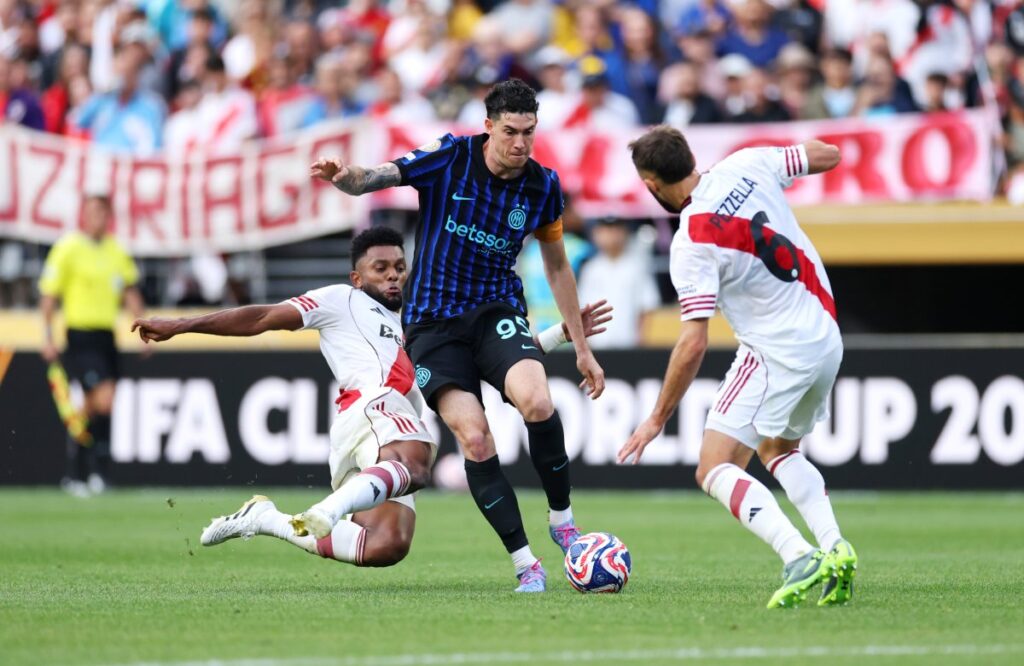Introduction: A Historic Upset in Charlotte
On June 30, 2025, Fluminense pulled off a remarkable 2-0 victory against Inter Milan in the FIFA Club World Cup Round of 16 at Charlotte’s Bank of America Stadium. Goals from Germán Cano and Hércules, combined with a masterclass from Thiago Silva, sent shockwaves through the football world. Beyond the pitch, sports technology played a pivotal role in this upset, from real-time analytics shaping tactics to platforms like DAZN enhancing global fan engagement. This article explores how cutting-edge tech illuminated Fluminense’s triumph in the Inter vs Fluminense Club World Cup 2025 clash.

Match Recap: Fluminense’s Tactical Triumph
The match began with a bang as Germán Cano headed home a precise cross from Jhon Arias in the third minute, setting the tone for Fluminense’s high-pressing strategy. Despite Inter Milan’s 68% possession and 16 shots (4 on target), Fluminense’s defense, led by 40-year-old Thiago Silva and 44-year-old goalkeeper Fábio, held firm. In stoppage time, Hércules sealed the win with a clinical low strike, threading the ball past Inter’s Yann Sommer. Opta’s analytics reveal Inter’s expected goals (xG) at 1.52 compared to Fluminense’s 1.13, underscoring the Brazilian side’s efficiency.
Sports tech was key to this upset. Platforms like Opta and StatsBomb provided real-time data, showing Fluminense’s high press disrupted Inter’s build-up play, which fans on X described as “static.” Jhon Arias, named FIFA’s “Superior Player of the Match,” exploited these gaps, completing 85% of his passes and creating three chances. This data-driven approach allowed Fluminense to outmaneuver a favored Inter side, who failed to score for the first time since the UEFA Champions League final.

Sports Analytics: The Brain Behind the Victory
Fluminense’s success wasn’t just about heart; it was about data. Tools like Wyscout and StatsBomb likely informed coach Renato Gaúcho’s strategy, emphasizing high pressing and quick transitions. Thiago Silva’s defensive metrics were standout: he led Fluminense in clearances (6) and interceptions (4), maintaining clean sheets in four of their last five competitive matches. Meanwhile, Inter’s reliance on possession-heavy play was countered by Fluminense’s compact low block, which analytics showed limited Inter to low-quality shots (average shot distance: 18 yards). Post-match, Inter’s Stefan de Vrij lamented to DAZN, “It was difficult to find spaces … they closed space well.” This defensive resilience, guided by real-time analytics, allowed Fluminense to neutralize stars like Lautaro Martínez, who hit the post but couldn’t convert. For tech enthusiasts, this match highlights how data analytics empowers underdogs to challenge giants, making sports analytics in football a game-changer.
Fan Engagement: Streaming and Social Media Buzz
The Inter vs Fluminense match reached millions thanks to DAZN, which offered free streaming in the UK (and ad-free for £14.99/month). This accessibility, coupled with interactive features like live stats and highlights, transformed the fan experience. In the U.S., the match aired on DAZN and Channel 5, though low attendance (30.6% of Bank of America Stadium’s 74,000 capacity) raised questions about FIFA’s marketing.

On X, fans buzzed about Fluminense’s upset. One user praised Thiago Silva as a “Rolls Royce of a footballer,” while another noted Inter’s defenders “looked like they’ve never met before.” These insights, amplified by social media, highlight how platforms like X and DAZN create a global conversation, blending real-time data with fan sentiment. For Technocrat Magazine readers, this underscores the growing role of DAZN Club World Cup streaming in uniting fans worldwide.
The Bigger Picture: Tech’s Role in Modern Football
Fluminense’s victory wasn’t just a sporting triumph; it was a showcase of technology’s transformative impact on football. From AI-driven analytics optimizing tactics to streaming platforms democratizing access, tech is redefining how matches are played and consumed. Fluminense’s data-informed strategy exemplifies how smaller clubs can leverage tools to compete with giants like Inter, who were favored in 84.6% of Opta’s pre-match simulations but faltered under pressure.

Looking ahead, Fluminense faces Manchester City or Al Hilal in the quarter-finals on July 4, 2025, in Orlando. Fans can follow the action on DAZN, where analytics will again play a starring role. For Inter, this loss caps a disappointing 2024-25 season, with no trophies despite ambitions of a treble.
As coach Cristian Chivu told DAZN, “It wasn’t our day … they were well organized.”
A New Era of Football Tech
The Inter vs Fluminense Club World Cup 2025 clash proved that technology is football’s unsung hero. From analytics empowering Fluminense’s upset to DAZN’s global reach, tech amplified every moment of this historic match. For Technocrat Magazine readers, this is a reminder of how data and digital platforms are reshaping sports. Want to dive deeper? Explore tools like Opta or catch the next Club World Cup match on DAZN to see tech in action.

Comments